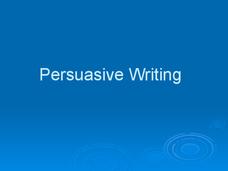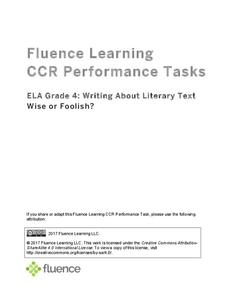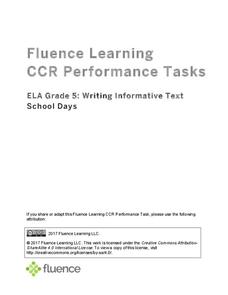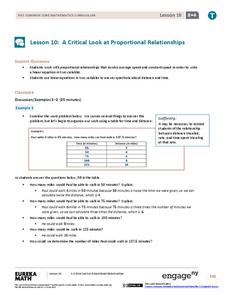Curated OER
Literary Analysis: Summary vs. Analysis
What is the difference between summary writing and literary analysis? A 16-slide presentation offers some basic requirements for both types of writing and helps readers identify each based on keywords used in both types of writing....
Curated OER
Persuasive Writing
Learning how to write a persuasive letter is a challenging, but fun writing style to learn. You can use this PowerPoint to introduce your class to persuasive writing. It provides a checklist, language features, and an example to...
Curated OER
Persuasive Writing
Prior to assigning your class their own persuasive writing task, present this PowerPoint and complete the task as a whole class. It outlines characteristics of persuasive writing, as well as includes a great learning activity. Your class...
Fluence Learning
Writing About Literary Text: Wise or Foolish?
A three-part assessment promotes reading comprehension skills. Class members read literary texts and take notes to discuss their findings, answer comprehension questions, write summaries, and complete charts.
Fluence Learning
Writing an Opinion: Student Council
A three-part assessment challenges scholars to write opinion essays covering the topic of the student council. After reading three passages, writers complete a chart, work with peers to complete a mini-research project, answer...
Curated OER
Writing Session: Writing a Summary
The similarities and differences between academic and everyday summaries/abstracts are explored in this PowerPoint. After reading "Historiographic Reflection on Israel’s Origins: The Rise and Fall of the Patriarchal Age,” and abstracts...
Curated OER
Integrating Quotations, Paraphrases, and Summaries Effectively
Integrating quotations, paraphrases, and summaries into a paper can be a challenge. After the terms are defined and the difference among them illustrated, viewers are shown correct and incorrect inclusions of quotations. Preview the...
Curated OER
Documenting Sources: An Introduction to Incorporating and Documenting Outside Sources in Your Writing
Text heavy, the 16 slides in this presentation provide specific examples to introduce researchers to documenting outside sources in expository writing. A follow-up activity or worksheet would provide an opportunity for guided practice.
Curated OER
Writing a Literary Analysis
What makes writing literary? What comprises analysis? A 15-slide PowerPoint presentation, created by the Purdue University Writing Lab, tackles these questions. The explanations of what makes writing literary and what comprises analysis...
Fluence Learning
Writing Informative Text: School Days
A three-part writing assessment challenges scholars to think critically about schools of the past and present. Learners read informative texts, answer questions to prepare for a discussion, research in small groups, complete a Venn...
Weber State University
Quoting, Paraphrasing, & Summarizing
Tattoos and piercings. Here’s a PowerPoint that uses an article on the tattoo and piercing craze to engage viewers in a presentation about citing sources. The 14 slides focus on how to add credibility to writing by including and citing...
Curated OER
Parts of a Friendly Letter
The art of writing a letter has not been lost to email and texting! Teach kids how to format a friendly letter with a presentation about the parts of a letter, as well as prompting them to write a letter about their favorite holiday.
EngageNY
A Critical Look at Proportional Relationships
Use proportions to determine the travel distance in a given amount of time. The 10th installment in a series of 33 uses tables and descriptions to determine a person's constant speed. Using the constant speed, pupils write a linear...
Curated OER
Writing Session: Evaluative Writing
This evaluative writing PowerPoint provides a framework for developing the critical thinking skills needed to critique literary selections. Deductive and inductive reasoning skills are featured as well tips for building a good argument...
Curated OER
Recounts: Writing a Summary
Have your class review how to summarize a story. Learners discuss the way to write a summary and talk about the use of sequence words. The presentation uses a graphic organizer. This helps to make it a visually appealing presentation.
Chicago Botanic Garden
Review and Assessment: Causes and Effects of Climate Changes
The last activity in the series of five is a short one where individuals show what they've learned about the causes and effects of climate change. Working independently, they fill in a graphic organizer, then compare their notes with a...
Orange County Schools
Piggybook
Summarizing text is a balancing act between being brief but thorough. You need to be short and to the point, but also cover all the important details, a task that presents a challenge for many young learners. In this lesson based on the...
National Sailing Hall of Fame
Sailboat Design Requirements
Sailboat design requires more than a half-circle and triangle sketch. After viewing a slideshow presentation that outlines the requirements for sailboat design, learners draw a design, perform the needed...
Curated OER
In-Text Citation
Wow! Here's a comprehensive look at the world of plagiarism. Types of plagiarism are defined, examples are shown, and in-text examples are highlighted. Being 75 slides long, this presentation is slightly overwhelming. Consider dividing...
Curated OER
Research and Documentation
Did you just assign a research project to your high school class? Begin the research process with this presentation. Give your class ideas about where to find information, how to evaluate sources, and how to properly cite them. The...
EngageNY
Some Facts About Graphs of Linear Equations in Two Variables
Develop another way to find the equation of a line. The lesson introduces the procedure to find the equation of a line given two points on the line. Pupils determine the two points from the graph of the line.
EngageNY
Linear and Nonlinear Expressions in x
Linear or not linear — that is the question. The lesson plan has class members translate descriptions into algebraic expressions. They take the written expressions and determine whether they are linear or nonlinear based upon the...
Los Angeles County Office of Education
Assessment for the California Mathematics Standards Grade 2
Test scholars mathematic skills with an assessment addressing addition, subtraction, multiplication, place value, measurement, geometric shapes, expanded notation; and their ability to compare numbers, write number...
Los Angeles County Office of Education
Assessment for the California Mathematics Standards Grade 1
Here is an assessment designed to test mathematicians' knowledge of writing numbers, comparing numbers, skip counting, solving addition and subtraction problems; along with measuring objects, telling time, identifying shapes, reading...
Other popular searches
- Writing a Summary
- Writing a Summary Paragraph
- 4th Grade Writing Summary
- Writing a Chapter Summary
- Summary Writing Powerpoint
- Writing Summary
- Nonfiction Summary Writing
- Teaching Summary Writing
- Writing a Book Summary
- Chapter Summary Writing
- Writing a Summary "Esl"
- Summary Writing Activities























